What Are The Different Types of Bleeding in First Aid?
Bleeding can be defined as blood loss from the patient’s circulatory system. The causes for bleeding can be different, including cuts on the external layer of the skin to deeper wounds and the kinds that occur due to accidents.
External bleeding and internal bleeding are the two broad categories of bleeding, and within these two categories are various kinds of bleeding those first aiders are taught about during their first aid training.
In this article, we will be diving deep into the different types of bleeding to learn more about the respective symptoms.
How Much Blood do we Have?
The amount of blood in our body varies in relation to our size. A rough rule is that we have approximately one pint of blood per stone in body weight (0.5 liters per 7kg), so the average adult has between 8 and 12 pints (4.5 to 6.5 liters) of blood, dependent on their size.
Remember that children have less blood than adults, and as such cannot afford to lose the same amount – a baby only has around 1 pint of blood.
What are the Different Types of Bleeding?
There are three main types of bleeding related to the blood vessels within the human body, namely arteries, veins, and capillaries. Every type of bleeding has its own treatments, causes, and procedures associated with it.
In order to treat a bleeding patient, it’s vital to know the kind of bleeding they are experiencing so that the casualty can be given the best care possible. Regardless of the type of bleeding you witness, it’s crucial to put direct pressure on the wound and act swiftly.
Although bleeding in some cases could be minor, the major cases that involve wounds to the veins or arteries can escalate into becoming serious issues. For instance, if a patient loses 40% of their blood, it can lead to organ failure, shock, or even death, in certain cases.
Here are the three primary types of bleeding to know about:
Arterial Bleeding
Arterial bleeding is the most severe and urgent type of bleeding, and it can occur when a patient’s organs or blood vessels get damaged or when there’s a penetrating injury or blunt trauma.
How to Treat Arterial Bleeding?
Apply direct pressure on the affected area to stop arterial bleeding. Ask the patient to hold the dressing in place in case they are in the right state to do so, and you can then seal the spot with a clean piece of gauze.
If you wish to check whether the bleeding has stopped or not, just pull your hand away to observe whether there is any blood leaking through the dressing. Remember not to remove the dressing altogether for this purpose.
Venous Bleeding
Venous bleeding can also be dangerous since veins carry a lot of blood, but it’s usually less life-threatening than arterial bleeding. The color of the blood, in this case, is often dark red as the blood that comes from our veins is deoxygenated.
How to Treat Venous Bleeding?
Treating venous bleeding is not much different from treating arterial bleeding. Use a clean pad to apply direct pressure on the wounded area and keep the pressure intact for five minutes. You can use your palm if the bound is big, or else employ your fingers if the wound is smaller.
Capillary Bleeding
Capillary bleeding is the least dangerous type of bleeding when compared to arterial and venous bleeding. It occurs when an individual faces an injury to their skin, and this kind of bleeding is much easier to control.
How to Treat Capillary Bleeding?
The process of treating capillary bleeding is the same as venous and arterial bleeding. After cleaning the wound with soap and water, you can remove any contaminants present in the wound. Control the bleeding by applying pressure, and make sure to wear gloves while applying the dressing.
External Bleeding Vs. Internal Bleeding
Internal bleeding refers to the bleeding that takes place within a patient’s body. This can occur due to any damage to the internal organs. A person can suffer from internal bleeding in the lungs, brain, intestines, knee, hip, joints, and so on.
External bleeding can include cuts, wounds, and nose bleeds. Wounds can be of different types, such as abrasions, lacerations, punctures, and avulsions.
Although external bleeding is easy to spot, it’s not always easy to identify internal bleeding. Based on the kind of internal injury a patient is going through, there can be various signs one should look out for.
Internal bleeding can cause swelling, pain, nausea, dizziness, paleness, extreme need for drinking water, shortness of breath, and clammy and sweaty skin. Uncontrolled bleeding is often the reason behind preventable deaths.
Therefore, when you witness someone experiencing an external injury, remove their clothes to see the source of the bleeding and use a cloth to cover the wound, and apply pressure in case a first aid kit isn’t available.
If a kit is available, though, make sure to apply a tourniquet if there’s heavy bleeding in the patient’s leg or arm.
Now that we have looked at the difference between internal and external bleeding let’s look at the numerous categories under these two types of bleeding.
Some of the different types of internal bleeding are as follows:
1. Intracranial Bleeding
Intracranial bleeding is the type of bleeding that occurs when a blood vessel inside the skull or cranium ruptures. It can occur due to high blood pressure that has been ongoing for a long time, thereby weakening the casualty’s arterial walls.
The symptoms of this include headache, vomiting, nausea, and experiencing weakness on one side of the body.
If you witness someone having an intracranial hemorrhage, take them to a hospital immediately so that a doctor can begin their treatment. This usually involves decompression of the brain so that the pooled blood can be released and the pressure can be relieved.
2. Pleural Cavity Bleeding
The pleural cavity is the area surrounding a human’s lungs. When this category of bleeding takes place, it affects the transfer of carbon dioxide and oxygen between the blood and lungs.
Symptoms of pleural cavity bleeding include dizziness, shortness of breath, and chest pain. Call an ambulance immediately when you see someone experiencing this type of bleeding.
3. Gastrointestinal Bleeding
When there’s blood loss from the organs in one’s digestive system, it leads to gastrointestinal bleeding.
The symptoms include abdominal cramps, vomit that includes blood, tiredness, shortness of breath, poop with blood in it or dark-colored poop, and fatigue.
Once a patient is taken to the hospital to treat a GI, they could go through blood tests, CT scans, and endoscopies depending on the kind of GI they are experiencing.
Now, it’s time to look at some of the types of external bleeding:
1. Abrasions
Abrasions occur when someone scrapes an area of their body on a rough surface, such as a child getting their knee hurt on a playground. These can heal by cleaning the wound or after applying dressing to the injury.
2. Lacerations
Lacerations refer to cuts on the skin, which are often the result of coming in contact with sharp objects such as broken glass or knives. Cover the wound and apply pressure in cases of deep lacerations and call the emergency medical services if the bleeding doesn’t stop.
3. Punctures and Avulsions
Punctures happen when a sharp or pointed object penetrates the patient’s skin. Avulsions can often cause life-threatening situations, and these often happen due to serious trauma, such as explosions or motorcycle accidents.
Punctures can be treated by applying pressure using a bandage or clean cloth for a couple of minutes. With an avulsion, let the clean dressing hold the pressure in place, which will ultimately lead to clotting and help in stopping the bleeding.
4. Postpartum Bleeding
Postpartum bleeding can happen whether one goes through a vaginal delivery or a cesarean delivery. The bleeding and discharge that takes place after a woman gives birth is known as lochia.
Give the patient some extra absorbent pads in order to control the bleeding.
5. Epistaxis
An epistaxis refers to a nosebleed. An individual faces a nosebleed when the tissue lining the inside of their nose loses blood. To help someone with a nosebleed, make them lean forward after sitting them down. Pinch the soft part of their nose softly for about 10 to 15 minutes. Cover an ice pack with a towel and place it on the back of their neck or their forehead. Make sure they are seated upright and not lying down.
How to Treat Bleeding?
Different types of wounds call for different types of treatments. Let’s take a look at the steps and guidelines to follow for various categories of bleeding:
First Aid for Minor Bleeding
Minor external bleeding is fairly easy to treat. You can make use of sterile gauze to clean the wound if you don’t have access to soap and water at that moment. Be sure not to employ a fabric that leaves behind debris in the affected area.
By keeping direct pressure on the wounded region, apply the dressing carefully. Since minor bleeding doesn’t pose the risk of massive blood loss, it’s essential to clean the wound first before you stop the bleeding so as to prevent the area from getting infected.
First Aid for Severe Bleeding
With cases of severe bleeding, it’s vital to call the emergency services immediately while you try to control the bleeding. Apply the dressing firmly and maintain a steady level of pressure on the area or ask the victim to hold the dressing in place if they’re conscious and in the state to do so.
You can apply a second dressing over the first one if the bleeding doesn’t stop after the first round of dressing. A tourniquet could be necessary in some cases. If there isn’t one available around you, you can make one using a t-shirt, bandage, or cloth.
Place the tourniquet over the injured area but never over a joint. For instance, if a person is hurt below the knee, place the material above the knee.
Make a simple knot with the tourniquet, tighten it by inserting a bar or stick into the knot, keep the stick secure by wrapping it, and ensure the tourniquet doesn’t stay on for over two hours.
First Aid for External Bleeding
Before you try to help someone who is bleeding externally, see to it that the ambiance is safe for the patient. If the bleeding is too severe, call an ambulance immediately. If it can be controlled through proper dressing, ensure you’re wearing the right type of protective equipment.
First Aid for Internal Bleeding
Since cases of internal bleeding are medical emergencies, the only thing you can do is ensure that the surroundings are safe for the patient so that no further injuries take place while you wait for the ambulance.
Be ready to help the patient in case they go into shock. Make sure they are lying on their back, keep them warm by covering them up, and remember that you might have to perform CPR if the situation calls for it.
Conclusion
Whether you’re a first aider or a bystander, it’s crucial to be aware of all types of bleeding. Knowing how to stop the bleeding, where to apply the required pressure, or how to seal the wound with the proper dressing can help you save the lives of strangers or anyone needing your help. When you know what every type of bleeding looks like and what its symptoms are, you can provide the necessary first aid accordingly and alert the EMTs to take charge of the situation whenever required.

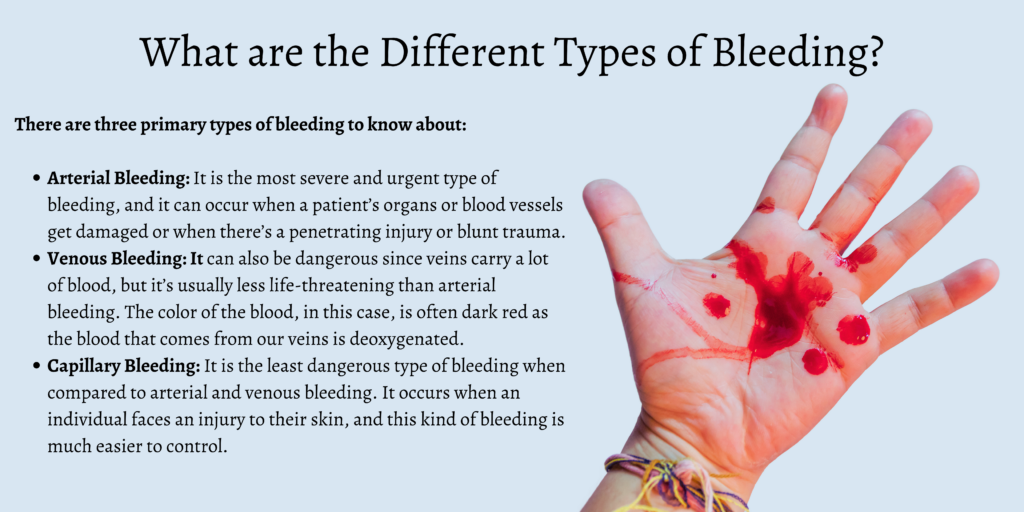
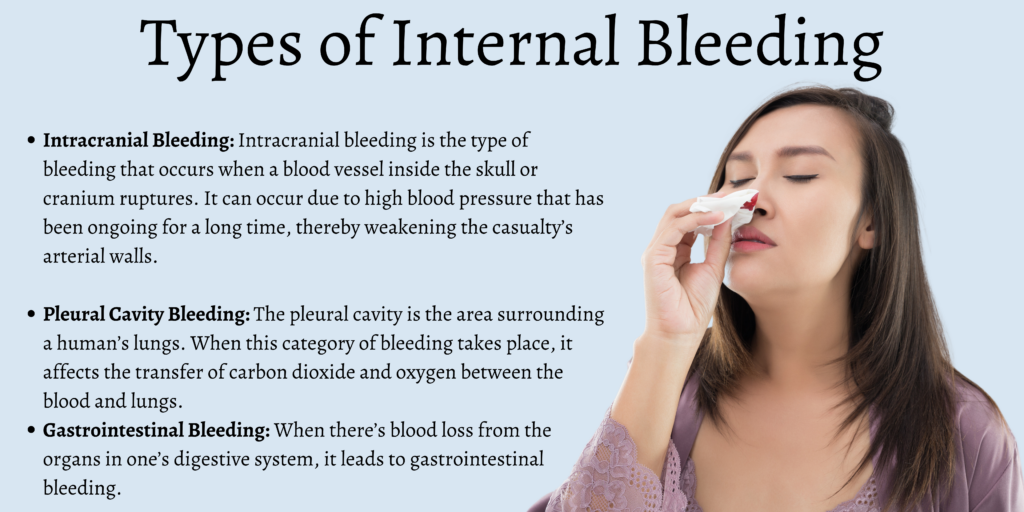
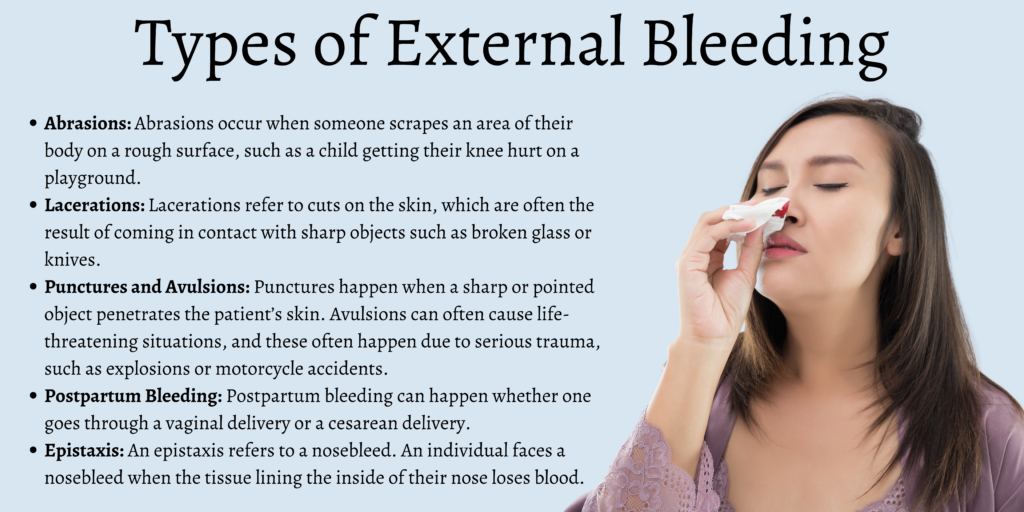
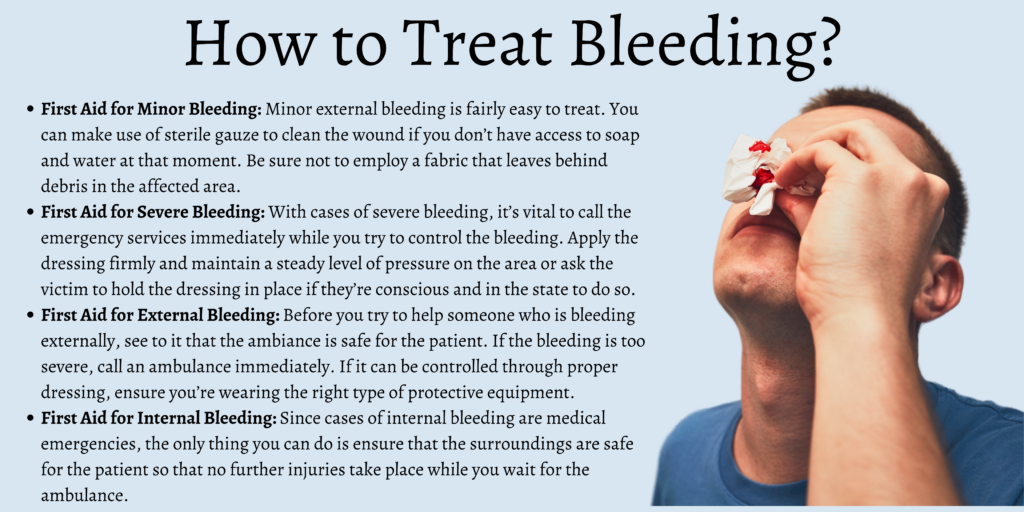

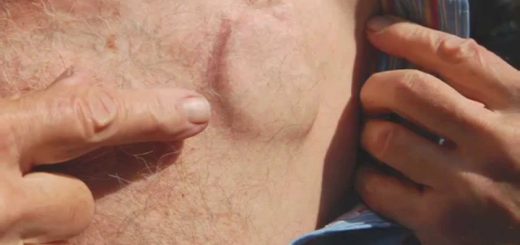
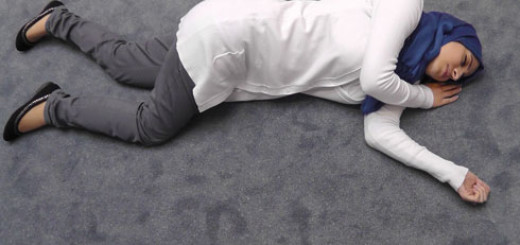


Hi. I am just writing from iran to inform you that nobody cares here about an injured person lying on the street after a typical car/bike crash. today I was coming back home from work when I saw a 70 year old woman crowded around by lots of bystanders and three police officers in the street. the driver who had hit her was also there. the sun was in full shine and no doctors were present at the scene yet. they were all waiting for the ambulance to arrive. nobody cared to get her on to their car for a possibly quicker and earlier outreach to the hospital. the police didn’t care either. the woman as i approached was still breathing but was unconscious (as if she was sleeping, yet clearly breathing regularly) and the nose had already bled but not all over the face (now the blood was dried) and no bleeding was visible around the mouth nor around the forehead. the pulse was normal as i checked it on her wrist and she was just lying there on the street with all the dresses she wore. I rushed into a nearby medical clinic (a small one) and asked the doctor to come over. she refused: “no, i won’t be able to help. this would have consequences for me”!!!!! i got upset and back to the scene where nothing was changed since my last visit in half an hour. my question please: i am so disappointed with such social system and would like to ask you pls if the police and the doctor were right not to make a hurry/ help? could it cause any liabilities, especially for the doctor, if she helped? please tell me if my own behavior or tendency (the way i see and treat such situations) is wrong and potentially dangerous. Maybe I am too hysterical and the way i look at the situation is wrong. were I in their shoes, I would examine her vital signs first, would decide if it was right to move her/ inject her with some helpful factors, then I would get her as soon and quickly as possible on a car ( my own car, upon the permission of the police force) then i would drive fast towards the nearest facility, then i would get in either to give my own blood or to help nurses find a blood donor. PLEASE let me know what was/ is the right attitude to tackle such scenes by the traffic accidents. I was just thinking about her and her loved ones. I am so sad and I am sure this sadness won’t help her anymore
Hi too… I am replying from Kenya.
I think the situation here in Kenya is a bit different from the one in Iran.
I believe you are not hysterical but rather humane. I believe that the soul purpose of learning this medical courses is to help someone and safe a life.
I also think that the doctor and the police who were at the scene are sort of selfish coz they will not get anything good in not trying to be time conscious in saving a life instead of thinking of their own welfare
interesting